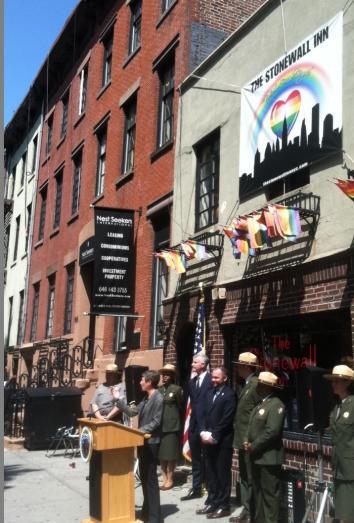Locating LGBTQ history—literally, marking where it exists in cities and off highways, inside meeting rooms and on maps—is a surprisingly tricky exercise. For instance, when gay (or gay-history-curious) friends visit New York, I often insist on leading a little walking tour of at least the West Village … but which sites to choose? Stonewall—site of the 1969 rebellion that is widely viewed as the pivotal moment in the early LGBTQ liberation movement—is a clear place to start, but what next? The Christopher Street Pier, once a febrile cruising ground and relatively safe space for gender-queering artists like those shown in Paris Is Burning, now a lovely (if rather anodyne) public park, is one option. Or how about any of the “last addresses” that filmmaker Ira Sachs included in his short documentary on the artists we lost to the AIDS crisis? On a less somber note, what about the basement of my local gay bar from which some of the most incredible drag in history has emerged?
That last one may not rise to the level of national significance, but many others do, which is why it’s good news that the National Park Service has decided to attempt to identify them. On Friday, in a press conference held outside the Stonewall Inn—currently the only LGTBQ site registered as a National Historic Landmark—Secretary of the Interior Sally Jewell announced that the service’s Heritage Initiative would undertake a new “theme study” meant to “identify places and events associated with the story of lesbian, gay, bisexual and transgender Americans for inclusion in the parks and programs of the agency.” Jewell pointed out that the job of the Park Service is not only to preserve the country’s natural treasures, but also “to tell the story of America,” including that story’s continuing civil rights subplot.
To do that, Jewell explained that the service will convene a panel of scholars, preservationists, and other experts over the next 12 to 18 months to identify between 10 and 20 sites worthy of inclusion on the National Register of Historic Places or, an even higher honor, being named a National Historic Landmark. Though the exact mechanism for doing so is not yet clear, she also indicated that the public will be invited to contribute to the discussion.
The Gill Foundation is helping fund the study as part of a public-private partnership, and foundation president Tim Gill praised the project as necessary in documenting the relatively “brief history” of the LGBTQ civil rights movement. But he also highlighted one of the struggles the panel will face, observing that this history is less one of “larger-than-life figures” than one made “by each and every individual who works for equality.” Plaques could be placed, he poignantly added, at any site where a son or daughter comes out to a parent or where a father explains his newly discovered sexuality to a child.
This is precisely the kind of tension the Park Service’s panel will have to contend with as it considers which sites to recognize, and, at a deeper level, makes decisions about what “LGBTQ history” even means. Given the complexity of the task, it’s doubtful we’ll all agree on the final list, but I think we can acknowledge that this is one case in which the process may be as fascinating as the result.
